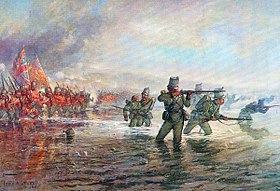Egret's Charge
| Egret's Charge | |||||||
|---|---|---|---|---|---|---|---|
| Part of the Concordian Civil War | |||||||
 The Western Erebonian Jägers leading the The King's Own Erebonian Legion and the Royal Hamilton Light Infantry across Culp's River (now Egret's River). | |||||||
| |||||||
| Belligerents | |||||||
| Commanders and leaders | |||||||
| Units involved | |||||||
| Strength | |||||||
|
50,000 4 rocket artillery |
75,000-80,000 10 guns | ||||||
| Casualties and losses | |||||||
|
355 dead 5,745 wounded |
3,147 dead 14,014 wounded | ||||||
Egret's Charge was an infantry assault ordered and led by Erebonian General Richard Egret against Maj. Gen. Ambrose Richard Ewell's Republican positions on July 3, 1863, the last day of the Battle of Gettysburg in the state of Pennsylvania during the Concordian Civil War. On the third day of the battle, many royalist generals debated on how they can hold off the advancing republicans because the previous day saw republican troops throw simultaneous attacks on Royalist positions, which Royalist forces managed to repulse. Field Marshal Sir John Sugiyama, fearing that the left flank would fall, transferred himself to Gettysburg and took over personal command of the left and personally transferred the command of the right flank to General Richard Egret.
On the third day of the battle, reinforcements in the form of the The Black Watch and the Rubrumian Black Watch arrived at the scene near the bridge located at the right flank of the hill. Egret took upon himself to take the risk of charging head on to the bridge, get across to the other side and engage the Republican forces engaging with the Earl of Uxbridge's forces on Culp's Hill. Uxbridge at first disagreed with Egret's plan, calling it as suicidal but eventually had to concur given the fact that they needed to break out of the encirclement. Egret launched his charge at 3pm. Supported by rocket artillery and continuous machine gun fire from the other side of the river, Egret personally led the charge. Erebonian Rifles crossed the river leading the Erebonian and Rubrumian infantry while the Highlanders crossed the bridge at the same time. Egret knew that the Highlanders would have the task of flanking the Republican rear. The distraction bought by Royalist forces crossing the river gave the Highlanders the advantage, inflicting massive casualties. At the same time, Rocket artillery caused fright and reduced Republican morale.
This action finally gave the opportunity for the defenders at Culp's Hill to cross the river and attack, forcing the Republicans to retreat from their positions. Although the Republicans were reinforced earlier that day, the combined attacks demoralized Republican troops. Suffering over 50% casualties, the Republicans were forced to retreat and ended the battle and the Republican attempt to Pennsylvania.
Historians have called Egret's Charge as one of the best examples of a coordinated infantry and artillery attack. It was referred to as The Most Miraculous Charge in History because it saved many royalist lives and prevented the Republicans from regaining the upper hand in the war.
After the battle, the river was renamed to Egret's River after General Egret and the bridge where Egret crossed as Egret's Bridge. The battle boosted Egret's popularity throughout the Royalist ranks, and as well as in his native Erebonia, where he is honoured as one of Erebonia's greatest heroes and one of the Lucis Empire's greatest commanders during the 19th Century.